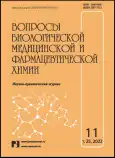Cellulase activity of mycelial fungi collection strains study
- Authors: Nikitina Z.K.1, Gordonova I.K.1
-
Affiliations:
- All-Russian Scientific Institute of Medicinal and Aromatic Plants
- Issue: Vol 25, No 11 (2022)
- Pages: 29-35
- Section: Articles
- URL: https://journals.eco-vector.com/1560-9596/article/view/113007
- DOI: https://doi.org/10.29296/25877313-2022-11-05
- ID: 113007
Cite item
Abstract
Relevance. Cellulases occupy the third place in the world among industrially produced enzymes. This is largely due to the fact that cellulose is the main component of plant material, and the lignin-cellulose part of biomass accumulates in huge quantities in the form of waste from agriculture, woodworking and other industries. To convert this material, it is necessary to perform its enzymatic cleavage to glucose and cellobiose using various cellulases.
The purpose of this work was to study the cellulose activity of collection strains of mycelial fungi for the selection of promising strains-producers of cellulases
Material and methods. The objects of the study were 13 strains of 12 species of micromycetes from the microorganisms biocollection of the VILAR, belonging to the genera Aspergillus, Monilia, Penicillium. The work used surface and deep cultivation of fungi on media with partial replacement of sucrose with cellulose. The cellulolytic activity of microorganisms was assessed by the growth rate of colonies. In addition, at the last stage of cultivation, the surface of the agar was stained with Lugol solution, the diameter of the lysis zones was measured and lysis indices were calculated.
Mushroom cultivation in deep conditions was carried out in flasks on a shaker. The seed material was a suspension of spores of seven-day deuteromycete cultures. In the culture fluid filtrates, the total cellulase activity was evaluated by determining reducing sugars, as well as the concentration of sucrose.
Statistical processing of the results, regression and correlation analysis were carried out on a personal computer using the Microsoft Office Excel 2010 statistical software package.
Results. During surface cultivation on a modified medium with cellulose, fungi formed colonies and well-defined lysis zones, which indicated the synthesis and secretion of cellulolytic enzymes. Differences in radial growth rates and lysis indices were found in individual species and strains of micromycetes. Using regression and correlation analysis, six strains were selected for deep cultivation. The presence of hydrolytic activity with respect to microcrystalline cellulose in the culture fluid of fungi during cultivation on a medium with partial replacement of sucrose with cellulose is shown.
Conclusions. The synthesis of cellulases was found by the studied fungal cultures during surface and deep cultivation. A comprehensive analysis of the data obtained makes it possible to select the most promising cellulase-producing strains.
Keywords
Full Text
About the authors
Z. K. Nikitina
All-Russian Scientific Institute of Medicinal and Aromatic Plants
Author for correspondence.
Email: nikitinaz@yandex.ru
Dr.Sc. (Biol.), Professor
Russian Federation, MoscowI. K. Gordonova
All-Russian Scientific Institute of Medicinal and Aromatic Plants
Email: gordonova777@yandex.ru
Ph.D. (Biol.), Leading Research Scientist
Russian Federation, MoscowReferences
- Bull A.T., Ward A.C., Goodfellow M. Search and discovery strategies for biotechnology: the paradigm shift. Microbial. Mol. Biol. Rev. 2000; 39: 122–127.
- Acharya S., Chaudhary A. Bioprospecting thermophiles for cellulose production: A review. Brazilian Journal of Micro-biology. 2012: 844–856.
- Srivastava N., Srivastava M., Alhazmi A., et al. Technological advances for improving fungal cellulose production from wastes for bioenergy application: A review. Environmental Pollution. 2021; 287: 117370. https://doi.org/10/1016/j.env-pol.2021.117370.
- Sulyman A.O., Igunnu A., Malomo S.O. Isolation, purification and characterization of cellulose produced by Aspergillus hy-pogeae shells. Heliyon 2020; 6: E05668. https://doi.org/10/ 1016/j.helion.2020.e05668.
- Jayasekara S., Ratnayake R. Microbial cellulases: an over-view and applications. 2019. In book: Cellulose. April 2019. Ch. 22. Publisher: IntechOpen. doi: 10.5772/intecho-pen.84531.
- Singhania R.R., Ruiz H.A., Awasthi M.K. et al. Challenges in cellulase bioprocess for biofuel application. Renewable and Sustainable Energy Reviews. 2021; 151: 111622. https://doi. org/10/1016/j.rser.2021.111622.
- Hadlar D., Sen D., Gayen K. A review on the production of fermentable sugars from lingocellulosic biomass through convertional and enzymatic route – a comparison. Int. J. Green Energy. 2016; 13: 1232–1253.
- Kuhad R.C., Deswal D., Sharma S. et al. Revisiting cellulose production and redefining current strategies based on major challengers. Renew. Sustein. Energy Rev. 2016; 55: 249–272.
- Roth J.C.G., Hoeltz M., Benitez L.B. Current approaches and trends in the production of microbial cellulases using residual lignocellulosic biomass: a bibliometricanalysis of the last 10 years. Apch. microbial. 2020; 202(5): 935–951.
- Bischof R.H., Ramoni J., Seiboth B. cellulases and beyond: the first 70 years of the enzyme producer Trichoderma reesei. Microb. Cell Factories. 2016; 15: 106–118.
- Paul M., Mohapatra S., Mohapatra P.K.D., Thatoi H. Micro-bial cellulases – an update towards its surface chemistry, genetic engineering and recovery for its biotechnological potencial. Bioresource Technology. 2021; 340: 125710. https://doi.org/10/1016/j.biortech.2021.125710.
- Semenova M.V., Gusakov A.V., Telicin V.D., Sinicin A.P. Fermentativnaja destrukcija celljulozy: osobennosti ki-neticheskogo vzaimodejstvija liticheskih polisaharidmonooksigenaz i individual'nyh celljulaz. Prikladna-ja biohimija i mikrobiologija. 2021; 57(5): 477–484.
- Nikitina Z.K., Gordonova I.K. Razrabotka metodicheskih podhodov dlja poiska producentov celljulaz. Voprosy biologicheskoj, medicinskoj i farmacevticheskoj himii. 2018; 3: 27–31. DOI: 10.29296/ 25877313-2018-03-05.
- Nikitina Z.K., Jakovleva M.B., Gordonova I.K., Chol Z.H. Sravnitel'naja ocenka rosta dejteromicetov pri ispol'zovanii razlichnyh beloksoderzhashhih substratov. Voprosy biologicheskoj, medicinskoj i farmacevtich-eskoj himii. 2015; 11: 56–59.
- Sinicyn A.P., Gusakov A.P., Chernoglazov V.M. Biokonversija ligninocelljuloznyh materialov. M.: Izd-vo MGU. 1995. 224 s. ISBN 5-211-03050-8.
- Gosudarstvennaja farmakopeja Rossijskoj Federacii. Izd. XIII. T. 1 OFS. 1.2.3.001915 Opredelenie saharov spektrofotometricheskim metodom. M. 2015. 1470 s.
- Moroz I.V., Mihajlova R.V., Shahnovich E.V., Lobanok A.G. Poisk gribnyh producentov celljuloliticheskih fermentov. Trudy BGU. 2013; 8(ch. 1): 221–223.
- Thyong F.K., Vu N.H., Hoa L.V., Jakovleva M.B. Biologicheskie harakteristiki mikromicetov, vydelennyh iz pochv botanicheskogo sada Bach Thao. Voprosy biologicheskoj, medicinskoj i farmacevticheskoj himii. 2011; 5: 24–28.
- Nikitina Z.K., Gordonova I.K. Ispol'zovanie othodov lekarstvennogo rastitel'nogo syr'ja dlja biotehnologicheskogo poluchenija gidroliticheskih fermentov. Voprosy biologicheskoj, medicinskoj i farmacevticheskoj himii. 2019; 9: 37–42. doi: 10.29296/25877313-2019-09-06.
- Ivchenko G.I., Medvedev Ju.I. Matematicheskaja statistika: Uchebnik. M.: Knizhnyj dom «Librokom». 2014. 352 s. ISBN 978–5–397–04141–6.
- Nikitina Z.K., Gordonova I.K. Ocenka celljulaznoj aktivnosti mikromicetov. Voprosy biologicheskoj, medicinskoj i farmacevticheskoj himii. 2018; 6: 20–26. DOI: 10.29296/ 25877313-2018-06-04.
Supplementary files












